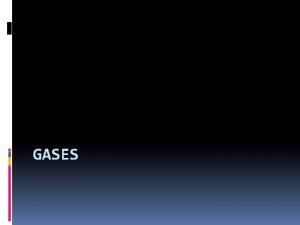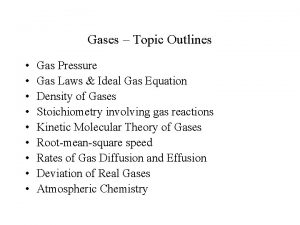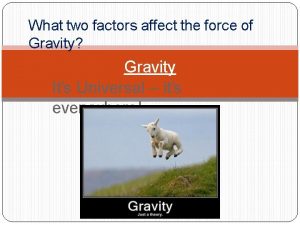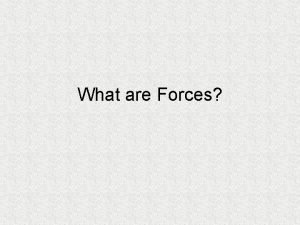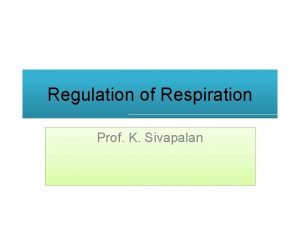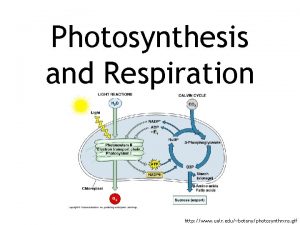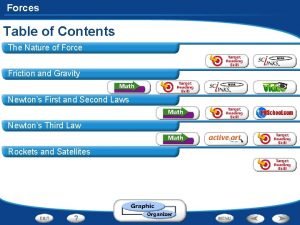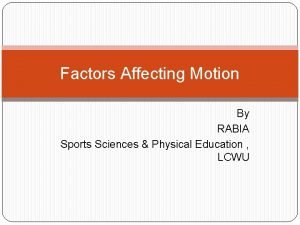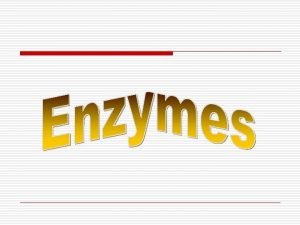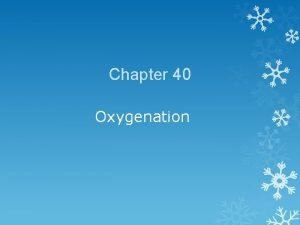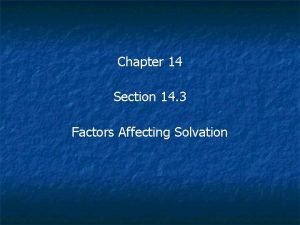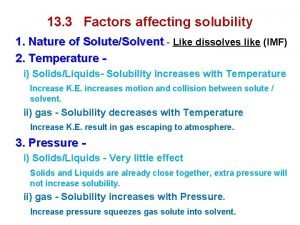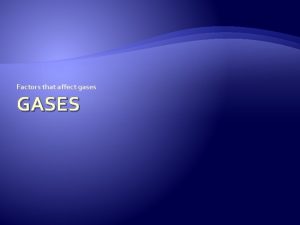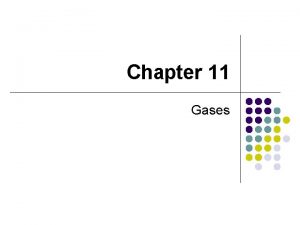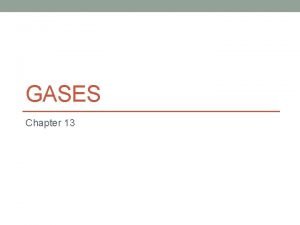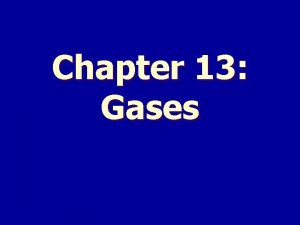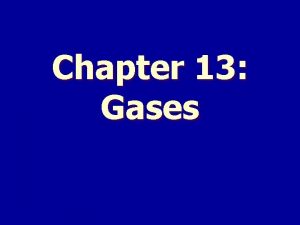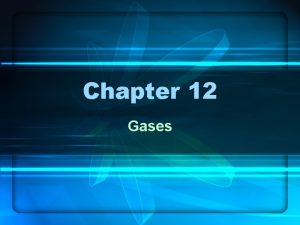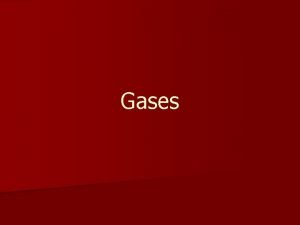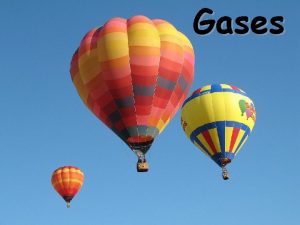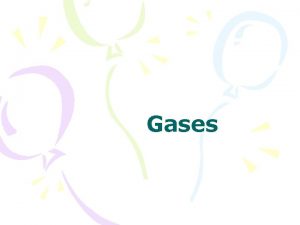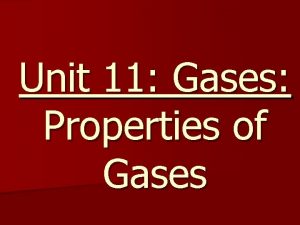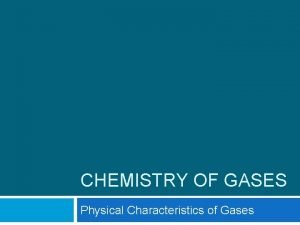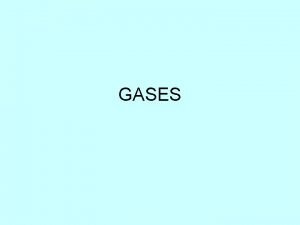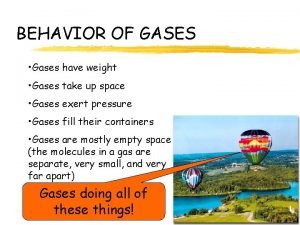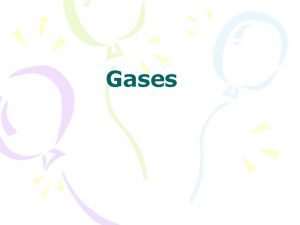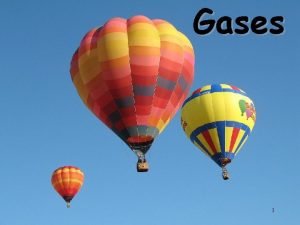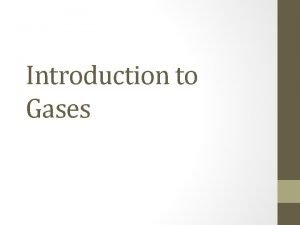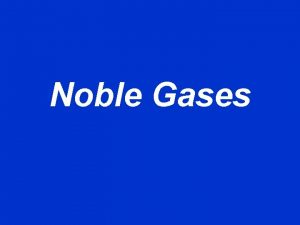Chapter 11 Gases Four factors that can affect




































- Slides: 36

Chapter 11 Gases Four factors that can affect the behavior of a gas. – Amount of gas (n) = moles – Volume (V), 1000 cm 3 = 1000 m. L = 1 L – Temperature (T), Celsius and Kelvins = o. C + 273 – Pressure(P), atmospheres(atm), mm. Hg, or k. Pa


Nature of Gases • 1 mole of any gas at STP equals 22. 4 L of volume. • STP is defined at sea level. – Standard Temperature = 0 o. C = 273 K – Standard Pressure = 1 atm = 101. 3 k. Pa = 760 mm. Hg = 760 torrs • Normal boiling point of water is 100 o. C at sea level. • Higher elevation lower boiling points. – Less Pressure above the surface of water.

Pressure and Force Pressure = Force / Area P = F/A • Reduce the area - Increase the Pressure • Increase the force - Increase the Pressure S. I Unit for Force - N (Newton) S. I Unit for Area - m 2 S. I Unit for Pressure - Pa (Pascal) = 1 N/ m 2

Standard Temperature & Pressure The volume of a gas depends upon • Pressure • Temperature In order to do a comparison of the volumes of various gases the gases must have the same temperature and pressure. Scientist agreed upon; STP - Temp. = 0 °C , Press. = 1 atm = 101. 3 k. Pa = 760 mm Hg

Dalton’s Law of Partial Pressure • The total pressure of a mixture of gases is equal to the sum of all the partial pressures. Partial pressure - pressure of one gas in a mixture of gases PT = P 1 + P 2 + P 3 + …

Sample Problem Determine the pressure of oxygen gas in a container that is under 1 atm of pressure and contains carbon dioxide and nitrogen. Note: PCO 2 =. 285 mm. Hg, PN 2 = 594 mm. Hg 760 mm. Hg = PO 2 +. 285 mm. Hg + 594 mm. Hg PO 2 = 165. 715 mm. Hg

Water Displacement page 859 A-8 • Gases are collected through water displacement. • Water vapor particles are trapped with the gas being collected. • Corrected pressure of the gas is determined through the following equation. Patm = Pgas + PH 2 O


Boyle’s Law: Pressure-Volume Relationship Boyle’s Law - the volume of a fixed gas varies inversely with the pressure at constant temperature. 2 Conditions P 1 V 1 = k P 2 V 2 = k (600) Then V = k 1/P or PV = k P 1 V 1 = P 2 V 2 If you know 3 you can find the 4 th

Sample Problem A sample of gas collected occupies a volume of 150. m. L when its pressure is 720. mm. Hg. What volume will it occupy if its pressure is changed to 750. mm. Hg?

Charles’ Law: Temperature. Volume Relationship The volume of a fixed amount of gas varies directly with the Kelvin temperature at constant pressure. V 1 / T 1 = V 2 / T 2 V 1 T 2 = V 2 T 1

Charles’ Law Temperature must be in Kelvin! Absolute Zero - lowest possible temperature, all kinetic energy ceases. -273. 15 °C

Sample Problem A sample of neon gas occupies a volume of 752 m. L at 25 °C. What volume will it occupy at 50. °C. P, n are constant.

Gay-Lussac’s Law • The pressure of a fixed gas varies directly with the temperature at constant volume. • Mathematically P = k T or P/T=k P 1 T 2 = P 2 T 1

Sample Problem The gaseous contents in an aerosol can are under a pressure of 3. 00 atm at 25 °C. If the temperature is increased to 52 °C, what would the pressure of the can be?

The Combined Gas Law • Expresses the relationship between P, T, & V of a fixed amount of gas. • Mathematically PV/T = k P 1 V 1 T 1 = P 2 V 2 T 2 P 1 V 1 T 2 = P 2 V 2 T 1

Sample Problem A helium-filled balloon has a volume of 50. 0 L at 25°C and 820. mm. Hg. What volume will it occupy at 650. mm. Hg and 10. °C?

Water Displacement • A sample of methane gas that was collected through water displacement had a volume of 350 m. L at 27. 0 o. C and 720. mm. Hg. What is the pressure at 2. 0 o. C and 250. m. L?

Avogadro’s Law • Equal volumes of gases at the same temperature and pressure contains an equal number of gas particles. • At STP, 22. 4 L = 1 mol • V 1 n 2 = V 2 n 1

Sample Problem • Determine the number of moles of helium that are held in a 250. m. L container. Consider that 2. 00 moles can be held in a 3. 00 L container.

11 -3 : Ideal Gas Law • Describes the physical behavior of an ideal gas in terms of pressure, volume, temperature and number of moles. • The combination of all 4 gas laws from the previous section.

Derived Equation for the Ideal Gas Law • Needed an Ideal Gas Law Constant (R). • The seconditions were set at STP to equal the ideal behavior.

Ideal Gas Constant

Practice Problem • A camping stove uses a propane tank that holds 4. 0 moles of liquid C 3 H 8. How many liters will be needed to hold the same amount of propane at 25 o. C and 3 atm?

Gas Density at STP • The density of a gas at STP is constant, due to the standard molar volume of a gas. • Non-STP: • However the density of a gas changes with temperature and pressure, due to the volume in the equation. (must use ideal gas law)

Gas Density Problems • Determine the density of CO 2 at STP. • What is the molar mass of gas that has a density of 1. 28 g/L at STP?

Molar Mass and Ideal Gas Law • Considering that moles are in the Ideal Gas Law equation, we can substitute the equivalent of moles(n) into the equation.

Density and the Ideal Gas Law • Now that mass(m) is in the equation we can substitute density(d) into the equation.

Molar Mass not at STP • Using the previous equations : Example: A 1. 25 g sample of gas was found to have a volume of 350 m. L at 20 o. C and 750 mm. Hg. What is the molar mass of this gas?

Ratm =. 0821 Rmm. Hg = 62. 4 Rk. Pa = 8. 314

Classwork 1. What is the molar mass of a gas that has a density of 2. 08 g/L at STP? 2. What is the density at STP of NO 2? 3. What is the molar mass of a gas, if it has a density of 3. 71 g/L at 22 o. C and 755 mm. Hg?

11 -4 Graham’s Law • Diffusion – Tendency of gas particles to travel toward areas of lower concentration. • Effusion – Gas escapes a tiny opening in a container. (one way diffusion) • Graham’s Law – Rate of effusion of a gas is inversely proportional to the square root of its molar mass. – Less mass = faster gas

Graham’s Law Problems • Which gas will diffuse into a container faster? CO 2 or NH 3? Why? • Compare the rates of effusion for F 2 and Cl 2.

Graham’s Law Problems At a certain temperature and pressure, Cl 2 has a velocity of. 038 m/s. What is the velocity of SO 2 at the same condition?

Determining the Molar Mass • An unknown gas was placed into a container with nitrogen gas. The N 2 was found to travel 1. 2 times faster than the unknown gas. What is the molar mass of this unknown gas?
 Phân độ lown ngoại tâm thu
Phân độ lown ngoại tâm thu Block nhĩ thất độ 3
Block nhĩ thất độ 3 Thể thơ truyền thống
Thể thơ truyền thống Thơ thất ngôn tứ tuyệt đường luật
Thơ thất ngôn tứ tuyệt đường luật Chiến lược kinh doanh quốc tế của walmart
Chiến lược kinh doanh quốc tế của walmart Tìm vết của đường thẳng
Tìm vết của đường thẳng Con hãy đưa tay khi thấy người vấp ngã
Con hãy đưa tay khi thấy người vấp ngã Tôn thất thuyết là ai
Tôn thất thuyết là ai Gây tê cơ vuông thắt lưng
Gây tê cơ vuông thắt lưng Sau thất bại ở hồ điển triệt
Sau thất bại ở hồ điển triệt Four properties of gases
Four properties of gases Properties of gas
Properties of gas Which two factors affect gravity
Which two factors affect gravity Ocean currents
Ocean currents What is force
What is force Factors influencing personality
Factors influencing personality Infectivity definition
Infectivity definition Factors that affect housing choices
Factors that affect housing choices Factors affecting ksp
Factors affecting ksp Physical property of solubility
Physical property of solubility Factors that affect respiration
Factors that affect respiration Factors affecting inertia
Factors affecting inertia Factors affecting respiration
Factors affecting respiration Factors that affect food security
Factors that affect food security What two factors affect the force of friction
What two factors affect the force of friction Local factors influencing wound healing
Local factors influencing wound healing What are the factors that affect the rate of dissolution
What are the factors that affect the rate of dissolution What factors affect projectile motion
What factors affect projectile motion Factors of motion
Factors of motion Le chatelier's principle
Le chatelier's principle Factors that affect enzymes
Factors that affect enzymes Enviromental health definition
Enviromental health definition Factors that affect respiration
Factors that affect respiration Diffusion in gelatin
Diffusion in gelatin Factors affecting oxygen administration
Factors affecting oxygen administration 3 factors that affect solvation
3 factors that affect solvation The factors that affect solubility
The factors that affect solubility










